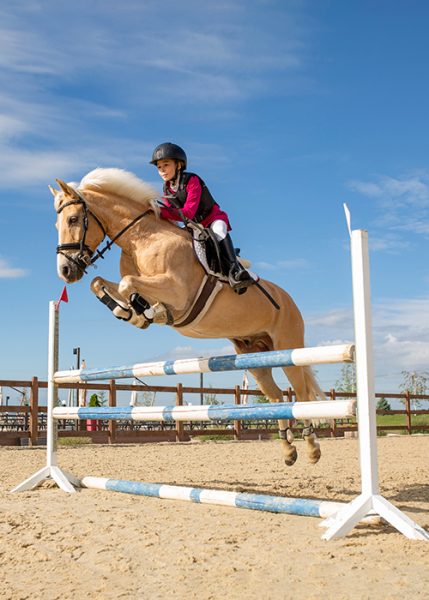
It can be frustrating to ride a horse that “rushes” his jumps. Rushing is when a horse approaches a fence too quickly. Instead of heading towards the fence in a collected, bouncy canter, he sticks his nose out and gallops at it at top speed. You try to slow him down by putting pressure on the reins, but he just pulls against you and continues tearing towards the fence at 100 miles an hour.
It’s no fun riding a horse that rushes at fences. It can be scary because you feel out of control. It can also be dangerous because a speeding horse is often an unbalanced horse. He may find it difficult to jump a fence nicely at top speed and may knock down poles. He could crash through the fence!
And if you can’t slow a horse down in front of a fence, you probably won’t be able to slow him down after a fence. This can cause problems when you’re jumping a course and need to approach the next obstacle in a controlled and balanced way.
Some people will just put a stronger bit on their horse, but this won’t solve the problem—in fact, a severe bit, such as a three-ring elevator or a Kimberwicke, can sometimes be “too strong” and can cause your horse to stop in front of a fence or jump badly.
Let’s look at a few ways you can try to slow down a speedy jumper before resorting to a stronger bit.
Flatwork & Lots of Transitions
You need to spend some time doing flatwork with your speedy horse. If you can’t control him at the trot and canter, you shouldn’t be jumping him!
Do loads of transitions every time you school on the flat. Stay in a 20-meter circle and work on transitions like trot to walk, trot to halt, canter to trot, canter to walk and canter to trot. Keep your horse thinking—and working! Doing lots of transitions helps to make your horse “lighter” and can make him pull against you less.
You need to be able to control your horse’s pace at the canter when jumping, so try this exercise. Pick up the canter and head around the arena. When you get to the short end of the arena, ask your horse to slow down and canter a 20-meter circle in a nice, bouncy, collected canter. Circle twice and then head out to the long side of the arena. Loosen your hold on the reins and really ask your horse to canter forward strongly. You want him to almost be galloping—but not quite. He should listen to your legs and move forward at a brisk pace.
When you reach the short side of the arena, take up your contact again on the reins, slow him down and put him back on a 20-meter circle. Once again he should circle with impulsion. After circling twice, loosen the reins and ask him to canter forward down the long side of the arena. Repeat this exercise one more time and then let your horse rest.
Poles
Set up three poles on the ground about nine feet apart (three big human strides) and then canter over them. The distances are a bit tight so your horse will have to shorten his stride to canter over them without breaking stride or knocking a pole. Really concentrate on keeping his canter bouncy—don’t let him get strung out and gallop over the poles.
Too Much Energy?
Some horses rush fences because they have far too much energy. They’re hyper! Is your horse getting too much feed for the amount of work he’s doing? Does he eat high-energy alfalfa hay, when he’d probably be calmer on low-energy grass hay?
If you don’t know much about feeding a horse, ask your vet or an equine nutritionist at the local feed store to develop a diet that might give your horse less energy so he won’t be so fired-up when you jump.
Circle, Circle, Circle
Set up a small fence (2 feet high is fine.) If your horse begins to rush as you begin your approach, circle him a few times in front of the fence until you feel like you have control over his speed again. Try to stay relaxed and then approach the fence again. When you’re about 20 feet away from the fence, ask him to halt. Give him a pat and then walk him towards the tiny fence. Let him jump it from the walk and pick up the trot after you land. Most horses can jump about three feet high from a walk, so popping over a 2-foot fence shouldn’t be too stressful for your horse!
Halt After the Fence
If your horse just bolts off at top speed after you jump a fence, do your best to get him to halt two or three strides after he lands. You’ll have to be strong and it might not be pretty the first few times you do this exercise! Sit up straight and take a hold of the reins and say “Whoa.” Stop him! When he halts, back him up a step or two, pat him on the neck, and then trot off and approach the fence again. After you pop over the fence, once again, halt him two or three strides after the fence, back up a step or two then trot off calmly in the other direction.
Placing Poles
Set up a placing pole about nine feet (three big human strides) away from the front of the fence, and another pole about nine feet after the fence. You can jump this exercise from both the trot and the canter. Placing poles encourage your horse to slow down and to think about where he puts his feet before and after a fence.


